UNIQUE COMPANY
Chugwater Chili continues longstanding traditions
Chugwater Chili, a unique company in Chugwater, was started in 1986.
Longtime Chugwater resident, Karen Guidice, says the town’s economic group was talking about the need for more employment opportunities – possibly bringing in a new business and new jobs – and decided to visit with the state for ideas.
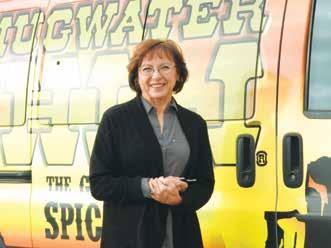
“The gentleman at the state office at the time knew Dave Cameron who created a wonderful chili recipe. He had been competing and winning numerous championships. Ironically, he called it Chugwater Chili,” Karen says. “Five ranch families got together with Cameron and bought the recipe, which is how the company got started.”
She adds, “The company started with just one product, and after a few years they created a dip, dressing mix, red pepper jelly and steak rub. The company continues to grow, recently adding a green chili seasoning and a hot chili seasoning.”
Products and trade shows Karen explains she purchased the company about 10 years ago.
“I absolutely fell in love with the product,” she states. “After doing trade shows and continually hearing ‘Wow’ and ‘This is the best chili I ever tasted,’ it was an easy decision. I had a business partner for the majority of the last 10 years and recently bought him out.”
The business continues to grow, with wider distribution. Sales are made online through wholesale customers, trade shows and the company’s retail store.
Chugwataer Chili currently has two full-time office employees and several parttime employees. Labor is also hired for trade shows.
In 2022, the company attended the National Finals Rodeo Cowboy Country Christmas Show at the Convention Center in Las Vegas.
“At one time we did 16 shows a year, but after COVID-19, we now only do a few shows. Customers sample our products at the trade shows, and once they try them, they want more. The beauty of the seasoning is once people taste it, they are hooked, and we have lifelong customers,” Karen mentions.
Karen also boasts all of their seasonings are five-star rated and award-winning. They plan to add three new products in the coming year.
“We just received a first place Scovie Award for our green chili,” she says.
Business and location Today, Karen and her husband own the company with an investor.
“My husband helps when I need him, but basically it is just myself and my marketing manager running the company. I am grateful to have really good help,” she says.

Chugwater Chili has their corporate headquarters on First Street in Chugwater.
“The facility is small, and we have outgrown it. Right now, we have a container that has all of our boxes and everything in it, and it is filled to the top,” Karen explains. “We do all of our packaging, marketing, sales and shipping out of our office.”
Karen notes Chugwater had the first State Land and Investment Board approved charter school in the state – Prairie View Community School.
“This is very exciting for Chugwater,” Karen says. “We currently have great businesses in town, the oldest working soda fountain in the state – Chugwater Soda Fountain – Tri-County Mercantile recently opened and the Stampede Eatery is a fun place to go. We are also very glad to have a gas station again. It’s fun to see these successful businesses really taking off.”
“The Chugwater Soda Fountain and the Stampede Eatery make our chili, so
when people come to town or stop on their way through they want a bowl of chili –either because they’ve heard about it or have seen our sign – we send them to the Soda Fountain or the Stampede Eatery so they can have some fresh, hot chili. The gas station, the Mercantile and the Chugwater Soda Fountain also sell our seasonings. If we are not open, people can get it there,” she says.
“We have big plans for 2023, and a lot of work to do. The main thing we want to do is get our three new products introduced and continue to grow. It’s a great company, and when people hear about Chugwater, their usual comment is ‘Oh! Chugwater Chili!’” she adds.
Karen, calls the Chugwater area home – a place where she has raised her family and a place where she continues her passion for chili.
“I worked for the town
and then went on to work in economic development and was the executive director of the Southeast Wyoming Economic Development District for several years,” says Karen. “I bought into the chili company with the intention


of having something light and easy to do when I retired. It is now a full-time job, however. Now, I love coming here to work every day.”
To date, Chugwater Chili has been and continues to be a very important business for
the little town of Chugwater. For more information, visit chugwaterchili.com Heather Smith Thomas is a corresponding writer for the Wyoming Livestock Roundup. Send comments on this article to roundup@wylr.net.
Business owner – Karen Guidice, longtime Chugwater resident, runs Chugwater Chili alongside her husband, investor and several full-time and part-time employees. Courtesy photo
Trade shows – Chugwater Chili attends several trade shows across the country. The company recently traveled to Las Vegas to attend the National Finals Rodeo Cowboy Christmas. Courtesy photo
IRVINE RANCH
Duncan Irvine and family continue Western lifestyle and ranching traditions

Duncan Irvine and his wife Brady reside in Platte County near Wheatland on a ranch the Duncan family homesteaded in the late 1800s and early 1900s.
“I grew up here and ended up coming back to the ranch. My brother Jason and I run it now. We lost our dad in 1994, but our grandfather was still alive at the time, and he helped out a lot,” says Duncan. “We lost him a few years ago. He was 90-plus years old and still going strong.”
Ranching program
“We have about 500 commercial Angus cows and an extensive heifer development program. We artificially inseminate (AI) the heifers. We keep most of the heifers we develop, but we also sell a few bred heifers,” Duncan says.
The ranch, strictly a cattle operation, has been raising cattle for a long time.

Duncan’s sister Amanda Sorenson and her husband Neal continue their involvement in ranching by running Powder River Angus near Gillette.
“When we were kids, everyone around here had Hereford cattle. Then we went to straight Angus,” he notes.
Year-to-year operations


Located in the foothills of the Laramie Mountains, the ranch leases some additional private ground for grazing while also utilizing a Bureau of Land Management (BLM) allotment. The cattle are able to graze nearly year-round.
“We are a cake outfit, we don’t feed a lot of hay. We usually get enough wind to clear away the snow. This is a very windy area,” Duncan says.
Cows at the Irvine Ranch calve fairly early in the year. Heifers start calving in the middle of February and the cows start around the 10th of March. The ranch finds importance in using windbreaks for their cows and calves.
“Getting through the dry years has been a challenge. We’ve had numerous droughts here, which has made it a real struggle. Also, the expenses keep going up. We’re probably making nearly the same amount of money every year, but we are not keeping up with inflation,” says Duncan.
“Today, it takes a semiload of calves to buy a pickup. A person has to be shrewd and pinch pennies
because there is no extra money. All it takes is one little mistake, and we might go under,” he continues.
Family involvement
The Irvine Ranch is a family operation. Duncan’s brother Jason and Jason’s girlfriend Kelly manage the south end of the operation, which is located along the Richeau Hills. Jason also has a son, Chase, who helps
on the ranch but also builds panels, chutes and has a welding shop.
“I have a son and a daughter who help when they can. My son Curran has his own excavation business and my daughter Logen and her husband Thain have a photography business. But, any time we can pry them away from their schedules, we gladly

take their help,” says Duncan. “We can’t afford to pay them, but they are really good about coming back when we need them to.”
He adds, “They all have an interest in the ranch, and they’d all like to come back. However, there’s not enough money in it, so they have to do sideline jobs,” he explains. “Everyone helps, though. My wife Brady
does all of the books and manages all the of banking, while also working a fulltime job and running the local conservation district. It’s a family deal and a team effort.”
Ranching challenges
Duncan notes ranching is a tough business, and it’s hard to get into. If the next generation wants to get into
Wyoming Livestock Roundup • 2023 Winter Cattlemen’s Edition B2 Extreme Weather Demands Extreme Outerwear Carhartt Insulated Yukon Extremes® CASPER 5050 E 2nd Street 307.237.8011 GILLETTE 410 E Lakeway 307.682.5053 ROCK SPRINGS 2400 Cascade Dr. 307.362.2991 Online: WorkWarehouseOnline.com
Continued on next page
Moving cows – The Irvine Ranch, located in the foothills of the Laramie Mountains, utilizes leased private grounds and a BLM allotment for grazing. Courtesy photo
ranching, it shouldn’t be about the money, but continuing ranching traditions and the Western lifestyle.

“If the next generation wants to ranch, they have to realize there is no money in it. It’s not about the money – it’s about the lifestyle,” Duncan says. “A person has to believe in what they are doing, find a way to make it work and be content with not having money. This is why most ranch families have at least one person who works at another job.”
“We struggle and work hard to stay afloat, but we love the lifestyle. There are a lot of private leases available. Many people have gotten older, are tired and







don’t want to do the ranch work anymore but don’t want to sell their land, so they lease it to someone else,” he mentions.










“There seems to be quite a lot of desire to hang on to the land, especially if it’s been a ranch that’s been in someone’s family a long time,” Duncan continues.
“People don’t want to give it up, but they are at a crossroad because they can’t make any money on it so they lease it out.”
He explains some of the land in his area has been subdivided, but not very much.
“This is such a windy place therefore not many people want to live here.
This area is best suited for cattle grazing,” Duncan says.
“Right around Wheatland there is a large irrigation district and some farming where they raise a lot of corn and crops, but aside from the irrigation district, moving into the hills it’s all ranch land,” he shares.
“My brother, myself and our sons all belong to a fire district which covers about 300,000 acres with approximately 30 families. It’s hard to generate much revenue for the fire district as it is mill levy supported,” he adds.
The cattle do well in this area, even though it is a harsh and windy environment.
“If we get a foot of snow, within about 24 hours, we get a Chinook wind. It will blow 50 to 60 miles per hour and clear the snow off most of the grass. I’ve seen two to three feet of snow, and after a good Chinook there may be drifts that fill the creek bottoms, but it opens up a lot of area for the cattle to keep grazing,” he says.
There can be extreme wind chill, but cattle have shelter in many places throughout the landscape.
“We can’t winter them out on an open field. In our region, a lot of cattle winter in the Richeau Hills in the southern part of the county. This is rougher country with mahogany and limestone breaks, which allow














cattle to get out of the wind,” he concludes. “A lot of cows also winter down along the river, west of Wheatland and up into the Laramie Range where our north ranch is located. The rougher it is, the better it is

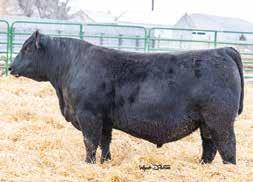

for wintering cattle.”

In summer months, cattle are moved out into more open areas and some are shipped to the Laramie Plains, located on Highway 34 at Morton’s Pass. It is higher in elevation but




excellent summer country for grazing.
Heather Smith Thomas is a corresponding writer for the Wyoming Livestock Roundup. Send comments on this article to roundup@ wylr.net.





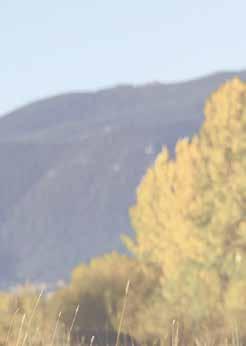
Wyoming Livestock Roundup • 2023 Winter Cattlemen’s Edition B3 WherePOWER & MATERNAL Meet Swift River Ranch Billings, Montana February 4, 2023 @ 1pm MST 1st Annual Sale Offering: 80 Bulls 40 • Yearling Bulls 40 • Age Advantage Bulls Cory Albin PO Box 966 • Red Lodge, Montana 406-794-1287 beartoothangus@gmail.com • Volume Discounts • First Season Guarantee • Free Delivery to Surrounding States Glenn Davis 219-776-7584 BEARTOOTH SIGNAL 1154 AAA# 20478943 BEARTOOTH ATLANTIS 1151 AAA# 20445651 BEARTOOTH EXCLUSIVE 234 AAA# 20484844 BEARTOOTH ICON 1612 AAA# 20173520 Ranch sign – The Irvine Ranch was homesteaded in the late 1800s and early 1900s. Today, the ranch is run by Duncan and Brady Irvine and family. Courtesy photo Continued from previous page
Strict cattle operation – The Irvine Ranch raises commercial Angus cows and utilizes an extensive heifer development program. They start calving in early February through March and brand their calves in the spring. Courtesy photo
DEDICATION TO RANCHING
When James’ father, Bill Goodrich, passed in 1989, James stepped up to take over the family farm and ranch at the age of 30.
With the help of his mother, and later his wife Conee, James was determined to keep the operation up and running.
Making his mark
As a fourth-generation rancher, James was determined to see what his family had worked so hard for in the past continue to be
successful.
Previously, his parents had calved and wintered cattle on a ranch Bill bought in 1958 near Laramie Peak. Because of harsh, inaccessible road conditions and James still working fulltime off the ranch, James knew there were some changes to be made.


“The bottom line is, we have to be able to adapt to our environment and surroundings to do what works best,” James says.
When his dad passed, James decided to quit wintering cattle near Laramie Peak and moved them down to his grandparents’ place in Wheatland, which has been in the family since 1895.
Calving changes
James also made the decision to start calving earlier after the move to Wheatland. However, after a few years of doing so, there needed to be another change.
“They were too confined, and it wasn’t a good place to calve. So, we moved back to late-spring
calving,” James says.
He notes they take cows back up to the mountain ranch to calve on their own through May and June. James keeps replacement heifers in a lot for either natural breeding or artificial insemination for early calving. The two-year-old heifers then calve in February and are bred to calve late the following year.
He notes this practice
has helped improve the rebreeding percentage of his heifers over the years.




Off-ranch success James and Conee have been able to not only keep and maintain the family ranch in production agriculture, but also pay off the ranch, even through the challenges which came in the 80s and 90s. James attributes a large part of this success towards the fact he


and Conee were able to work off the ranch in order to pay off debt.
James was fortunate enough to work though the fall and winter at the National Western Stock Show in Denver as the livestock manager and be back on the ranch by spring in time to calve. He could then stay through the summer on the ranch before heading
Wyoming Livestock Roundup • 2023 Winter Cattlemen’s Edition B4 Call 402-920-3171 • nickjindra@hotmail.com • www.jindraangus.com Ad Design by Chrisman Cattle Services Sitz Resilient • Linz Exemplify • Woodhill Domain • Jindra Superior Jindra Assurance • Sterling Pacific • Jindra Acclaim • Tehama Patriarch Tehama Tahoe • Jindra Perfection • Jindra Strategy • Hoover No Doubt Scotch Cap genetics Selling Tahoe x Jindra Double Vision BW 74 Adj. WW 855 $C 298 L ot 1 - 20499632 Jindra Superior x Guinness BW 86 • Adj. WW 835 • $C 280 L ot 69 - 20499613 Domain x Limited Edition BW 78 • Adj. WW 800 • $C 247 L ot 72 - 20499633 PROTECT WHAT MATTERS MOST At Woolington Agency, we provide custom insurance quotes from trustworthy agencies, built to fit your unique lifestyle. From home, auto, farm, and more, we can find an insurance solution for you! will@wyoagency com CONTACT US +307-322-9129 www.wyoagency.com When asked what James Goodrich is most proud of when it comes to his operation, he simply laughs and says, “The fact that we’re still in business.”
James Goodrich shares
success based on hard work
Ranching traditions – As a fourth-generation rancher, James Goodrich of Wheatland has worked hard to continue his family’s ranching traditions. Courtesy photo Continued
on next page
“Keep your expectations realistic. Don’t think you’re going to learn it all in a short period of time or you’re going to become extremely successful overnight.”
– James Goodrich
back to Denver in the fall.
In 2007, James took on the position of director for the Wyoming State Fair. With this career change came a lot more windshield time in order to balance the ranch work.
“I was in the office and on the fairgrounds all week, and then I would be back on the ranch for the weekends,” James said. “I’ve spent a good portion of my life driving.”
Ranching advice
When it comes to a young person trying to make it in the cattle business, James advises, “Keep expectations realistic. A person isn’t going to learn it all in a short period of time or become extremely successful overnight.”
As an example, James shares the story of a young man from Meeker, Colo. who didn’t come from a ranching family or background but desperately wanted to make it in the cattle business. While this ambitious young man had very few assets and even less experience to draw on, he was determined to be a cattleman.
The young man started out by buying bum calves and hauling them in the back of his car to a set of corrals he was borrowing on an old farmstead.
James continues, “He was obviously working another job as well, but he started raising these calves. It got to where he could buy himself some heifers and started a cow herd for himself. Pretty soon he worked up to where he owned a couple hundred head of cows.”
Now retired, James and Conee get to enjoy working on the ranch full time.
James and Conee, as well as the young man in his story are a testament to the saying, “Where there is a will, there is a way.”
While it might take sacrifice, hard work, dedication and even a second job, if one is determined enough, they can make a bright future in the cattle business.

Aften Peterson is a corresponding writer for the Wyoming Livestock Roundup. Send comments on this article to roundup@ wylr.net.


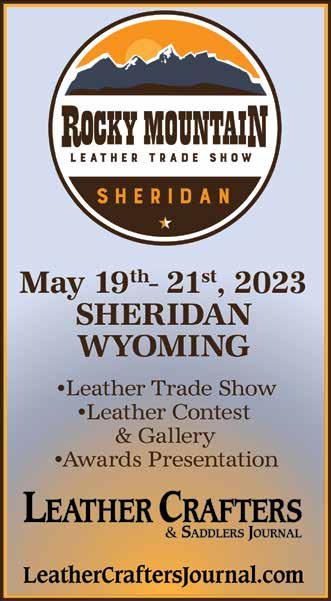




Wyoming Livestock Roundup • 2023 Winter Cattlemen’s Edition B5 Molly Folot 970-218-1185 Learn More & Stay in Touch MLS Territory Managers: mlstubs.com info@mlstubs.com Midcontinent Livestock Supplem nts MLS Proven Performance MLS #15 Hi Energy Improve forage digestibility and increase intake this winter with MLS Tubs that are available 24/7. calving and breed back for your herd. Don’t Gamble With Cow Body Condition MLS Tubs Are A Sure Bet Molly Folot 970-218-1185
Homeplace – James Goodrich keeps his two-year-old heifers on the ranch outside of Wheatland to calve in February, while his cows return to the mountain ranch to calve May through June.
Courtesy photo
Continued from previous page
Wyoming landscape – The Goodrich’s ranching operation began atop a ranch on Laramie Peak in 1958. Today, the ranch is located outside of Wheatland, but still utilizes a mountain ranch for a late spring-calving season. Courtesy photo
BRICKMAN RANCH
Started from scratch and steeped in tradition
Doug Brickman comes from a long line of farmers and ranchers, but his upbringing did not line him up to inherit a generational ranch. Instead, Doug started from the bottom and worked hard in pursuit of the American dream.
Although Doug was born and raised in Alaska, his father’s family was from the Wheatland area. Doug moved to Wyoming when he was 20 years old, and took jobs cowboying on the Petsch and True ranches.
He also punched the ticket working on a dairy farm in Wisconsin and putting up small square bales in Kentucky. All of this experi-
ence set him up for success when it came to taking on his own operation.
Family involvement
At the age of 29, Doug and his wife Anne bought a ranch from Don and Jerry Cundall north of Wheatland on Cottonwood Creek.

Almost 30 years later, the operation is still going strong. The couple raised their two children on the ranch and homeschooled them so they could get a real world education in addition to their schoolwork.
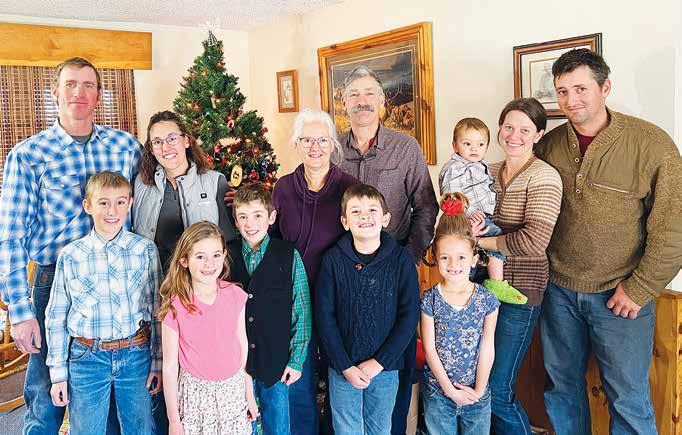
“In addition to the homeplace, we also managed a pretty sizable operation on the plains for quite a few years. We managed about
100,000 acres up there. We would take our cattle up in the summer and then take in several thousand cattle for
other people,” says Doug. “When my kids were teenagers, they did some pretty serious cowboying, and I
partnered with them on our operations up there.”
Doug and Anne’s children are now grown and have children of their own.
Doug’s son Kent, his wife Kaelea and their three children live on the ranch and run cattle and sheep. Doug’s daughter Karmen lives near Bosler and ranches with her husband Lane Stevenson and their three children.

As with many operations, everyone at the ranch has a side hustle to help stay ahead of the game. In addition to being a weekend warrior on the ranch, Anne has been a lifelong emergency room nurse. Kent has a contract fencing business. Over the years, Doug has spent time driving a semi or taken in outside cattle.
Western lifestyle
“We’ve done what we need to do in order to hustle up whatever we can find for more income and try to hang on to our quality of life,” explains Doug.
And to the Brickmans, quality of life means trying to do things as traditionally as possible. Even on the coldest days, one can find them bundled up on horseback instead of an ATV.
Doug raises and trains his own horses, including draft horses or work mules to pull a feed wagon in the winter. He has even built special wagons adapted to feeding modern hay bales.
For many years, the family made an eventful tradition of trailing cattle home from the Laramie Plains. The trail took five days. When the kids were younger, they would recruit friends to come along and help.
The family built their own chuckwagon they would pull with a team of mules along the trail.
Though the tradition took a short hiatus, Doug expects the trail ride will be resurrected this year along a different route, now that the grandkids are old enough to participate.
Cowboy yacht
Doug has become well known for his tinkering and ingenuity. In 2000, he bought a tugboat on the West Coast and brought the hull home to fix it up. He re-plated the hull and built the cabin of the boat at the ranch before hauling them back to the West Coast to reconstruct the boat.
Wyoming Livestock Roundup • 2023 Winter Cattlemen’s Edition B6
Continued on next page
Three generations – Today, three generations of the Brickman Family live on the ranch. Anne Brickman photo
Doug’s cowboy yacht, as he calls it, is completely refurbished and has made many sea voyages for the Brickman family.

“They called me Noah when it was sitting here by my shop. It was such an odd thing for this part of the world. It’s 45 feet long so it’s a big boat. In between ranching, I’ve taken my family on several cruises in the Pacific Northwest, even as far as Alaska and back on the inside passage,” says Doug enthusiastically. “I taught myself all of the navigation since I had never been on the
ocean before.”
He adds, “We’ve had wonderful times with our family and friends, many of my ranching friends have joined us.”


Doug epitomizes what it truly means to work hard and build the life one has always dreamed of. The Brickmans spend their days chasing Red Angus cattle and living out their American Dream.

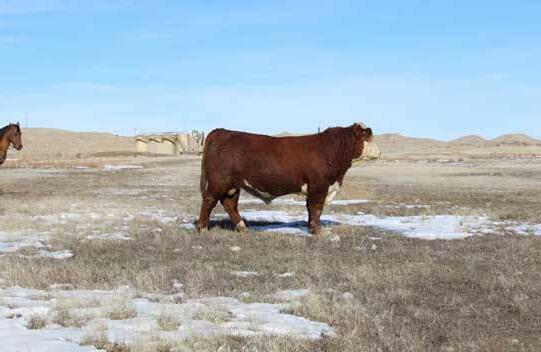


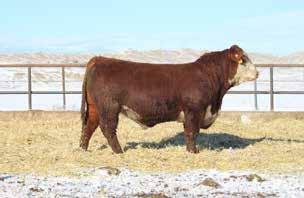
Tressa Lawrence is a corresponding writer for the Wyoming Livestock Roundup. Send comments on this article to roundup@ wylr.net.


Wyoming Livestock Roundup • 2023 Winter Cattlemen’s Edition B7
Continued
previous page
from
American dream – Doug Brickman, an Alaska native, now resides north of Wheatland and trains horses to use on his ranch. Anne Brickman photo
D> WEDNESDAY, FEBRUARY 8, 2023 SALE HELD AT BIG HORN BASIN LIVESTOCK IN WORLAND, WY / 1 P.M. MST CATTLE FOR COMMERCIAL COWMEN FROM COMMERCIAL COWMEN Annual Bull Sale 100 2-year-old PAP tested, range-ready Hereford bulls 250 F1 baldy heifer calves Contact us for a catalog or more information. Bruce & Mary Agar 307-867-2402 dcrwyo@yahoo.com Wyatt & Joey Agar 307-921-8825 durbincreekranch@yahoo.com Jake & Hannah Agar 307-867-2403 durbincreekranch@gmail.com DCR 199B COWBOSS 1352 / P44407990 DCR 7059 TRUE GRIT 1012 / P44255615 LOT 92 DCR DVB 8179 ENDURE 1512 / DCR DVB 8179 ENDURE 1546 / P44315846 LOT 7 DCR DVB 8179 ENDURE 1541 / P44315844 LOT 6 DCR 199B COWBOSS 1433 / P44407994 LOT 64
Cowboy yacht – Doug has become well known for his tinkering abilities, and one of his most rewarding accomplishments is a boat he refurbished for family adventures in the Pacific Northwest. Anne Brickman photo
Diversified operations are often applauded as the epitome of success and future planning. The Goertz family and K2 Red Angus are a prime example of the full-circle nature of a diversified cattle and farming operation.
Their Wheatland-based operation includes both registered and commercial herds, as well as a contract with Wyoming Pure and Natural Beef. Kim and Jason Goertz also farm wheat and other crops on both dry and irrigated land.

The pair both have extensive backgrounds in cattle. Kim worked for many years as a full-time artificial insemination technician, and Jason grew up on a commercial cattle operation.
Registered Red Angus
With a goal to raise functional, fertile and efficient cattle, the family forgo making decisions based on expected progeny differences (EPDs), and instead, choose and raise cattle they know will grow to be functional working cattle.

Kim’s journey with registered cattle began in 1998 when she bought her first registered cow. She notes she was in the registered cow business for about 10 years prior to her and Jason getting married and joining their operations.
“When we got together our operation grew more than I could have ever imagined,” she says. “We now run both a spring and fall calving herd and have two sales per year to market our cattle.”
“We emphasize maternal traits and pulmonary arterial pressure (PAP) test
and leg structure to make sure they can travel in rough country,” she continues. “We are not big on EPDs. These are not show cows. They are ranching cattle, and we treat them as so.” “A big part of what
“Because of this, we know what the everyday rancher needs, and we keep a really rigid quality standard on the cattle we sell.”
Kim notes they offer a guarantee on their bulls, and she once thought she lost a customer because he did not return for nearly six years.
“He finally called me after six years and said he was ready to pick up new bulls since his original set needed to be replaced. It made us feel really good about the quality of our bulls,” Kim says.

Wyoming Beef
Jason’s parents started Wyoming Pure and Natural Beef in 2004. They began using their own commercial herds. Later on, Kim and Jason took over the management of this commercial herd and added some of their own cattle as well.
Kim notes Wyoming Pure and Natural Beef processes cattle almost exclusively through their family’s operation.
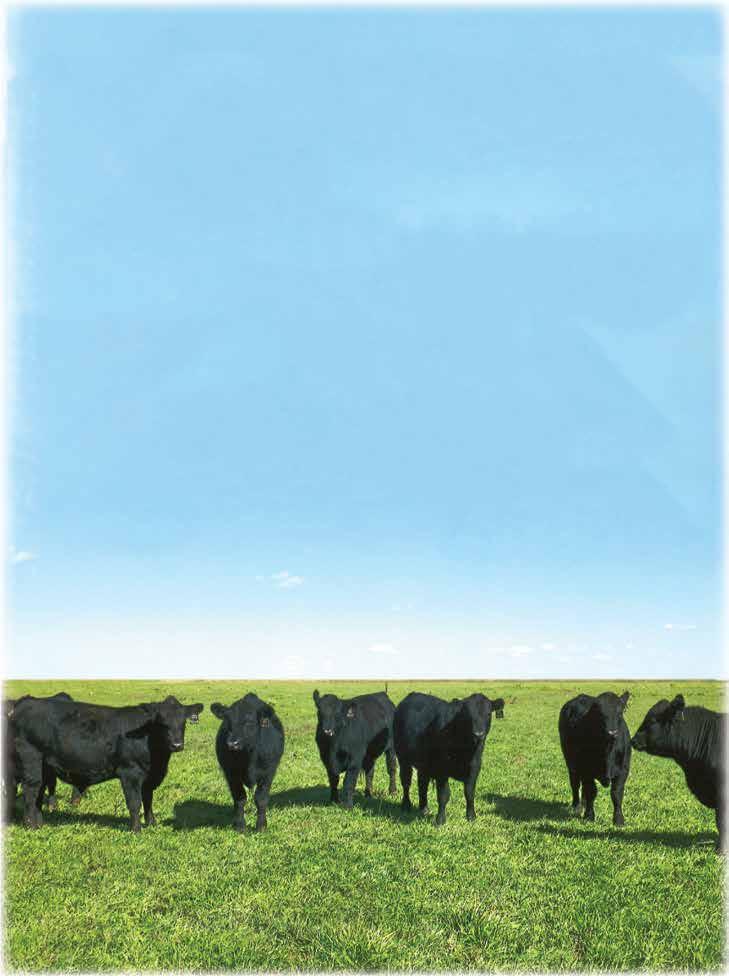
“Wyoming Pure and Natural Beef purchases beef from Wyoming producers. A lot of the beef from outside of our family operation comes from our bull customers, so in a way it is tied into our registered operation,” she shares.
“It is really neat to get to sell beef from people we know,” she says. “People can put food on the table for their families and know exactly where those cattle have been and how they were taken care of,” she continues.
The company offers custom cuts, but customers can also purchase quarters, halves or whole sides of beef as well as specialty
meats such as sausage.
The family has also had a working relationship with the 307 Meat Company in Laramie where they have worked with the management of the facility and provided meat.
Moving forward
Kim notes a majority of the goals surrounding their operation stem from including their now 17-year-old twins in the operation if they want to be a part of it.
“One of our biggest goals is to stay viable and continue to grow,” she says.
“For us, this has looked like taking on new enterprises in order to get the next generation involved. If we can continue to grow and expand with cattle and crops, we can take on more people on the operation in the future.”
Kim notes her husband Jason deals with the farming side of their operation more so than anything.
“He does a lot of the farming, but we both pull our weight where we can. The registered cattle are my passion, and we have been blessed to continue selling bulls for the last 20 years,” she says.
“We have worked for 20 years to get our bull and female sales built up, and it was definitely a flywheel process,” concludes Kim.
“We just want to continue to grow and move forward and improve the quality of our cattle, as well as our reputation among our buyers.”
For more information, visit K2redangus.com


Callie Hanson is a corresponding writer for the Wyoming Livestock Roundup. Send comments on this article to roundup@ wylr.net.

B8 Wyoming Livestock Roundup THE TRADITION CONTINUES Tuesday, February 14, 2023 • 1 p.m. Torrington Livestock, Torrington, WY Selling Angus Bulls sired by the best bulls in the breed for Calving Ease, Performance and Carcass Quality SELLING 65 YEARLING ANGUS BULLS G BAR H GENETICS ANGUS BULL SALE G BAR H GENETICS Other sire groups: KR Storm 900, Poss Rawhide, J&J Weighup 294, KR Quality, Hoffman Thedford View and Bid on dvauction.com Boone & Melanie Heiting 307-575-5520 Kevin & Jackie Nickel 307-837-2279 • 307-575-0373 (cell) Bill & Dana Haas 307-837-2925 • 307-575-0294 (cell) 3146 State Hwy 154 • Veteran, WY 82243 G BAR H GENETICS Boone & Melanie Herring 307-575-5520 Bill & Dana Haas 307-837-2925 307-575-0294 (cell) Kevin & Jackie Nickel 307-837-2279 • 307-575-0373 (cell) 3146 State Hwy 154 • Veteran, WY 82243 Other sire groups: KR Storm 900, Poss Rawhide, J & J Weighup 294, KR Quality, Hoffman Thedford Deer Valley-Growth Fund 4 sons, 5 grandsons sell Sitz-Resilient 10208 5 sons sell G BAR H GENETICS Boone & Melanie Herring 307-575-5520 Bill & Dana Haas 307-837-2925 307-575-0294 (cell) Kevin & Jackie Nickel 307-837-2279 • 307-575-0373 (cell) 3146 State Hwy 154 • Veteran, WY 82243 Other sire groups: KR Storm 900, Poss Rawhide, J & J Weighup 294, KR Quality, Hoffman Thedford FULL-CIRCLE OPERATION K2 Red Angus personifies the diversified cattle operation
– In
the
marketing
commercial herd
company
Natural
the company
processes beef
seedstock
Diversified operation – K2 Red Angus, owned and operated by Kim and Jason Goertz and their two children Cole and Laynie, includes both commercial and registered herds of cattle, a contract with Wyoming Pure and Natural Beef and farming on dry and irrigated lands. Courtesy photo
Marketing local beef
2004,
Goertz family started
beef from their
through their
Wyoming Pure and
Beef. Today,
also
from some of K2 Red Angus’
customers. Courtesy photo
Wyoming Livestock Roundup • 2023 Winter Cattlemen’s Edition
“A big part of what I believe sets us apart is we both come from very strong commercial cattle backgrounds. Because of this, we know what the everyday rancher needs, and we keep a really rigid quality standard on the cattle we sell.” – Kim Goertz
Learn more at vitalix.com. Contact your Sales Manager today! Ralph Hinton (970) 966-4904 | rhinton@vitalix.com
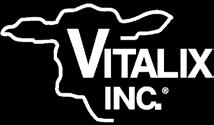
Healthy newborn calves and improved conception rates start with cow herd nutrition. Vitalix Tubs are the ideal delivery system to provide essential nutrition for calving. Vitalix uses technologies that are proven to improve colostrum quality, calf health and immunity, all while supporting the mother cow now, and more offspring to come. TRUE BLUE

TRUE BLUE NUTRITION FOR ANY CONDITION.
VIX_VitalixAds_CalvingAd_8.75x11.25_r2v1 1 1/12/23 10:04 AM
RAISE STRONG. THEM
BOOTIQUE WEST
Tina Willis of Wheatland owns and operates Bootique West, a traveling Native American jewelry business. Tina grew up on the Andrew Kortes and Sons Ranch in northern Carbon County on the North Platte River.


“We were isolated, remote and didn’t have a telephone growing up,” she says. “We raised cows, sheep and horses.”
Tina’s family has owned the property since 1914. Although Tina is no longer involved with the operation, she states she is grateful for growing up
on a ranch and being surrounded by agriculture as a child.
“I am very proud of my ranching background, of my grandparents, parents, aunts and uncles, and I am grateful for their examples of honesty, hard work and faith in God,” she says.

Tina’s husband Dick was raised on a ranch in Arizona and permanently moved to Wyoming in the 1970s. Both Tina and Dick worked closely with agriculture through their past careers.

Dick worked for Vigor-
facili-
Bootique West history
Tina’s love for Native American jewelry started at a young age.
“When I was a baby, my father brought back turquoise jewelry from Native Americans in Tucson, Ariz., so I grew up seeing the jewelry in our house in Wyoming,” she says.
In 2003, Tina was diagnosed with neurological invasive West Nile. Her diagnosis included encephalitis, meningitis and polio. She was paralyzed on her left side with great diminishment. The neurological damage was deemed permanent.
Tina could no longer work and was struggling to find activities she
could do. Tina’s daughter-in-law saw Tina struggling with daily tasks and decided they needed to find an activity for Tina to spend her time doing.
“She watched me fumbling and stumbling and not being able to do anything,” says Tina. “She asked if I could play the piano, or perhaps paint, and I couldn’t. Then, she asked me if I could do beadwork, and I figured I could.”
Tina went to a shop for jewelry supplies and purchased rocks with holes in them and chains to make necklaces.
“I would sit and force myself to use my left hand to make the little necklaces,” she says.
After months of beading necklaces, Tina had
This is the first time in many, many years this land is being offered for sale. Just over 3,375 deeded acres located about 15 miles southwest of Wheatland. Accessed by a major highway and about 8 miles of county maintained road. Land has been used for grazing of pairs year round in the past and more recently yearlings in the summer months.
Offered for sale at $2,920,240
tone Ag Products, and Tina was employed as a
tator with the Wyoming Department of Agriculture and a district manager for the Converse County Conservation District.
Wyoming Livestock Roundup • 2023 Winter Cattlemen’s Edition B10
offered for sale. For more information and details of this offering, contact:
Wyoming native range land
Bob Brockman, Broker-Keyhole Land Co., in Wheatland at 307.331.0909.
range land offered for sale.
Wyoming native
Tina Willis shares her passion for Native American jewelry with customers
Continued on next page
State fair – Tina Willis owns and operates Bootiqe West, a traveling Native American jewelry boutique. Pictured is the boutique set up at the Wyoming State Fair in the Pioneer Cabin. Courtesy photo
four necklaces made, and Dick suggested Tina should bring the necklaces to a Wyoming Stock Growers Association (WSGA) meeting and sell them at his booth.
Tina sold her first piece of jewelry at the WSGA convention. Her husband Dick began working for Vigortone Ag Products in 1986, and even after he was promoted, he continued to attend the WSGA trade show for 35 years.
“I didn’t think anyone would buy them, but I took my four little necklaces which had taken me months to make, laid them on the table and people bought them,” she adds. “I think they bought them because they felt sorry for me, but it was appreciated. I realized it was something I enjoyed doing.”
Tina’s friends at WSGA suggested she should start selling Native American jewelry.
“My friends said, ‘You wear all this beautiful Native American jewelry, why don’t you buy some of it and bring it to WSGA?’” she says. “It seemed like a crazy idea to me to spend money on jewelry and then sell it to people.”
“I had never had a sales job in my life,” Tina adds.
Tina took her friends’ advice and purchased four small Native Americanmade necklaces.
“I took those and some of my homemade necklaces back to the next WSGA meeting, and they bought them,” she says. “My husband told me to take the money I made at the meeting and buy more jewelry.”
Tina recalls Dick saying, “You’re good at this. You can do this.”
“Thanks to the generosity, spirit and pocketbooks of WSGA members, Boo-

tique West came about,” Tina says.
Trade shows
Tina does not have a storefront for the Bootique West, she solely sells the jewelry at trade shows. She attends WSGA and Colorado Cattlemen’s Association meetings, Cheyenne Frontier Days and the Wyoming State Fair each year.



American jewelry, no lon ger selling her homemade necklaces.
selling Native American jewelry and mine,” she says.
ate about the high-qual ity jewelry she sells and says she fights the fraud ulent importation of jew elry made in places off shore such as the Philip pines and Thailand.
Native Americans I know and trust,” she says. “I work predominantly with the Navajo Nation.”
ing jewelry from Native Americans in 2006 when
I laid my first piece on a table at a WSGA trade show,” she adds. “We now have over 2,000 pieces.”
WSGA members and the opportunity she has to showcase Native American jewelry at conventions.
feel so at home at WSGA conventions,” she says.
Love for the business
Tina is grateful for the opportunity to sell Native American jewelry.
“Jewelry is a very personal thing,” she says. “It is amazing to me how different pieces speak to different people.”
Tina has enjoyed getting to know the Native Americans who make the jewelry she sells.
“The Native Americans’ dedication to their craft and their ancestors comes through every
piece of jewelry, and then it lays on the table and someone is able to pick it up, take it home and add it to their personal collection,” she says.
Tina values the jewelry she sells and is happy to know the pieces will be loved and cherished by the next owner.
“I am so happy to con -
to me. To go to WSGA and see all those friends is wonderful,” she says.
Tina feels she and Dick have been blessed.
“The most important thing to Dick and I is our faith in God and His divine provenance in taking care of us and making this little jewelry business into such a wonderout for us.”
For more information,
responding writer for the Wyoming Livestock
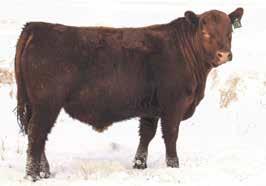
Wyoming Livestock Roundup • 2023 Winter Cattlemen’s Edition B11 k2redangus.com Feb rua r y 2, 202 3 Sell ing 100 head Jason & Kim Cullen Goertz Wheatland, WY 307-331-2917 kcullen@wyoming.com Bu lls yearli ng & 18-month h -old He ifers registered yearling heifers Lunch at noon, sale at 1 -At the K2 Sale barn, Wheatland, WY Continued from previous page
Business owners – Tina Willis started Bootique West after Tina made and sold four handmade necklaces at a Wyoming Stock Growers Association meeting. Today, Tina and her husband Dick sell Native American jewelry. Courtesy photo
“It is amazing to me how different pieces speak to different people.” – Tina Willis
RANCHING HERITAGE
The Buffington Family Ranch, owned and operated by Jim Buffington, is located in Platte County and parts of Albany County. Jim’s parents, Don and Janet, are still involved in the operation.
“Our house is in Albany County, and all the rough grazing land is in Platte County. Our kids go to school in Converse County, so sometimes we get spread a little thin,” Jim says.
Ranch history
The Buffington’s homeplace ranch was started in 1909, but the original homestead was built at a lower elevation.
“I lease the land where our ranch was originally homesteaded now, but 1909 was when it all started,” says Jim. “My mom’s side of the family started this ranch, and then my great-aunt had it. We moved up here in 1990. Then my dad bought out my great-aunt. The ranch was in shares. My mom got her share from her mother. There’s a third share belonging to my great-aunt who lives in California.”
He adds, “I am fourth generation, and my kids are fifth generation.”
The ranch originally raised Hereford cattle.
“When my dad came here from Nebraska, he had some put-together cows. We got into South Devon and then switched to Red Angus. Now we’ve added a little Simmental for hybrid vigor,” he notes. “A good commer-
cial crossbred cow can do the job on these rough pastures.”
Ranching operation

The family does everything horseback in their big pastures. In 2012, they had a fire burn the entire place. Afterwards, they rebuilt fences and added more.
“We move the cattle a lot more than we used to,” Jim mentions. “When I was a kid, we just turned them out for season-long grazing, but today, we move them frequently. It’s better for the grass and the cattle.”
Half of the Buffington Family Ranch consists of rolling hills. The other half is rough and rocky, but cattle can still graze it.
“We try to raise cattle that are fertile, ambitious and can climb up into the rocks. They need to be like mountain goats,” he says. “We have good water, but it’s not next to the grass, so cattle have to travel between feed and water. We have a lot of good summer country but not much winter country.”
“We lease a place for winter pasture, but we have to trail our cattle there about 12 miles, usually in December. This pasture lasts longer in winter months, and we try to rough the cows with a little protein so they can keep grazing. We try to run them pretty cheap,” Jim explains.
Breeding process
Most of the cattle on the Buffington Family Ranch are bred through artificial insemination
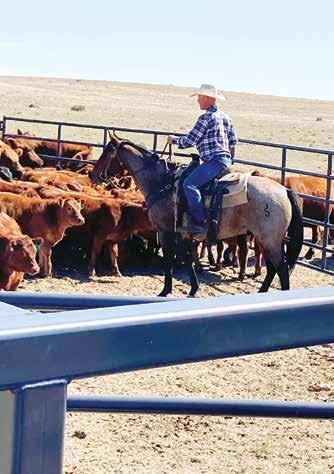

(AI). Jim learned how to AI in 2007 and uses only the best heifers as replacements.
“We AI all our heifers and half of the cows. I pick the better half of the cows to AI and raise replacements from them. We rough the heifers pretty hard. We like to keep the ones that will breed in those conditions – they make the best cows,” he explains.
After AI, Jim gives heifers 21 days with a bull and that’s it. He used to keep them in a feedlot over winter and have a great breed-up. However, they would start to fall apart and wouldn’t breed back for their second calf.
“The second calvers were falling out of the herd like crazy, so we changed our strategy,” Jim says.
He prefers cattle with some hybrid vigor. After trying to work with South Devon cows, the ranch
switched to Red Angus.
“We used to have big, red South Devon cows, but they had too much frame and milk and were monstrous cattle. We needed something to reduce frame size, so we looked at Red Angus. My uncles raise Angus. My grandfather on my mom’s side had some Red Angus too, so we got bulls from him. We liked them, so we started using them. Once we started using AI, we could pick any bull we wanted,” he says.
“When I was a kid, I could see the Red Angus bulls out there breeding cows on a hot day, while the black bulls would be all shaded up. Red Angus are also a super maternal breed, so they make good cows,” Jim explains.
“When we select our replacement heifers, our most important criteria is who their mothers are. We like to choose heifers
Wyoming Livestock Roundup • 2023 Winter Cattlemen’s Edition B12 BECAUSE RANCH SAFETY SHOULD NEVER HAVE TO BE A PROBLEM. CHOOSE THE GREEN, YELLOW AND RED CHUTE FOR SAFER CATTLE HANDLING. COVOLO AUTO-FARM SERVICE 307.786.2277 • 800.635.2475 80 Rees Rd. • Mountain View, WY • www.arrowquip.com
Buffington Family Ranch focuses on raising high-vigor cattle
Horsepower – Jim Buffington raises and trains his own ranch horses. The whole family rides and helps with cattle work. Pictured left to right, Kent, Jim, Tate, Tinley, Don and Ty Buffington. Courtesy photo
Continued on next page
Working cattle – The Buffington Ranch raises Red Angus cattle with Simmental influence. Courtesy photo
from our best cows. I probably select half the heifers this way and the other half based on looks,” he continues. “There are some that just don’t fit what we want when we are sorting them.”
Recently Jim notes he started adding Simmental lines into his herd for diversity.
“We were needing something else in the herd because it was becoming straight Red Angus. We needed more hybrid vigor. Since starting AI, I now keep some of my own

bulls because buying bulls is so expensive,” he says.
He adds, “When a rancher keeps a bull from one of their own cows, they know a lot more about the cow’s line and her genetics. They can often raise something just as good and a lot cheaper than what they can buy. Ranch-raised bulls are also well adapted to their environment and don’t fall apart.”
Jim further notes, “I can’t afford what I like. I have champagne taste and a beer budget. We started
raising our own bulls. We were spending money to AI the cows, so we thought we might as well keep a few bulls.”
Overcoming challenges
Ranching in this area comes with many challenges, weather being one of the hardest.
“I make great plans in the spring but can’t always follow through with them, so we have to be flexible. The markets are also a challenge when raising cattle,” says Jim.
He shares input costs have gone up, especially with high inflation today.
“We have to be careful and keep inputs low. We just keep plugging away, being cautious and keeping our nose to the grindstone. Hard work and determination go a long way,” he says. “People say we need luck, but I feel hard work will lead to success if we keep after it. We also can’t be afraid to try different things. Trial and error is the best teacher
because it’s not just what to do, but what not to do.”
“Wheatland and Douglas are good communities to work with. There are a lot of good folks and good neighbors who are always willing to help each other,” he adds.
Raising ranch horses

Jim raises and trains his own horses to use on the ranch.
“My dad used to work at the Haythorn Ranch in Arthur, Neb. and got some of those bloodlines. The Haythorn family was the first in Nebraska to register Quarter Horses, and are world famous for their working ranch horses,” Jim says. “We always have a handful of horses we are raising, and I usually break them. We have a lot of country to make wet saddle blankets.”
He notes going miles and miles and learning on the job is the best way to make a good cow horse. Giving a horse a job to do keeps their mind occu-
pied. This way they learn more and don’t become as bored as working in an arena or round pen.
Horses learn how to handle themselves in rough country and become more surefooted and agile.

“It really helps to give them something to do. My dad and my brother like a fast horse, but I prefer one with a lot of cow smarts, so that’s what I like to raise and train,” says Jim. “Where we have a lot of rough country to cover to manage the cattle, a good horse is a big help. We move the cows around a lot with rotational grazing.”
Family involvement
Jim and his wife Jodi have three children, two boys and a girl.
“Our oldest boy Tate is 12 years old, Tinley is 10 years old and Ty is six years old. They are already good help. The two older ones are eager to help, always asking when we are going to go do something,” mentions
Jim. “They help me with AI-ing and all of the cattle work. Sometimes, Tinley thinks she’s the boss and runs the show, thinking we need to do things her way.”
Jodi teaches Kindergarten in Douglas.
“She has to support me. It always seems like someone in the family has to work off the place to make a farm or ranch financially stable. Our place isn’t quite big enough to support us and my folks,” Jim concludes. “As some people might say, ‘It’s just big enough to starve to death,’ but it’s a great life.”
Jim appreciates the fact his dad has been willing to let him try new things and learn what works and doesn’t work on their ranch.

Heather Smith Thomas is a corresponding writer for the Wyoming Livestock Roundup. Send comments on this article to roundup@wylr.net


Wyoming Livestock Roundup • 2023 Winter Cattlemen’s Edition B13 Family involvement – Jim Buffington’s children help on the ranch. His son Tate is 12 years old, Tinley is 10 years old and Ty is six years old. Courtesy photo Continued from previous page WWW.MRANGUSRANCH.COM Jennifer Reyes-Burr 5104 Hwy 34 • Wheatland, WY 82201 307-331-1530 (cell) mrangusranch@gmail.com KMR Angus • Keith Russell 21419 WCR 13 • Johnstown, CO 80534 970-587-2534 • 970-371-7819 (cell) kmrangus@gmail.com MR Angus • Juan Reyes 98 Olson Rd • Wheatland, WY 82201 307-322-4848 • 307-331-1568 (cell) Succession coordinators work with families and operations to navigate the transition of the ag operation to the next generation. The coordinators work in tandem with attorneys and accountants to make sure that the succession plan is feasible. FARM SUCCESSION Navigate The Transition Succession coordinators work with the family to identify: • Where is the operation now? • Where do you want it to be? • How do you get there? Succession coordinators are available as a service of the Wyoming Agriculture & Natural Resource Mediation Program. For more information, contact Lucy Pauley at 307-777-8788 or email lucy.pauley@wyo.gov.
After growing up on a dairy farm on Highway 34 between Wheatland and Laramie, Keith Geis always knew he wanted to end up on a farm or ranch. As a kid, his parents raised 100 head of dairy cows and had 500 acres of irrigated row crops, which meant Keith was no stranger to long days and hard work at a young age.
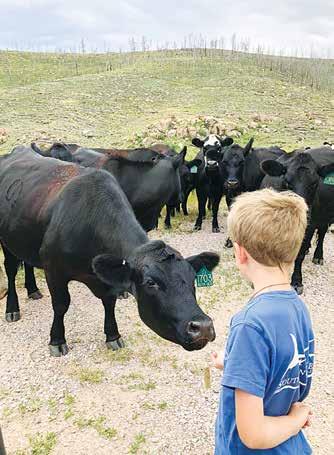
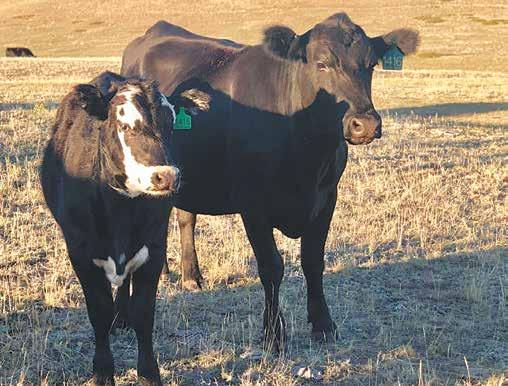


After high school, Keith wanted to explore his options, so he went to the University of Wyoming where he received a degree in economics. After graduation, he took a job with the U.S. Department of Agriculture before moving his career to banking.



Throughout his lifetime in the banking industry, Keith always kept one foot in agriculture.

Ranching inspiration
“In the early 1980s, there was ‘Black Friday’ where the stock market crashed. I came home and told my wife Marie what we had lost in the downturn in the market, and I didn’t even have any fun losing that money. I thought I might as well buy some cows so I could enjoy gambling with my money,” Keith says with a laugh.
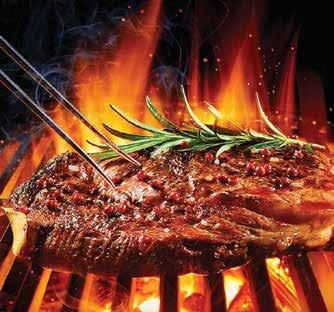
Keith says this moment was the catalyst which inspired him to get back into the production of commodities. He became a self-proclaimed weekend warrior, banking for 50 hours a week and ranching in the evenings and on the weekends.
“This was a really positive thing. I was experiencing the same challenges my customer base was expe



riencing. I could relate to them on a much more meaningful level,” says Keith. “It gave them the opportunity to ask, ‘Since you're somewhat familiar with this, why don’t you give us a hand?’ And that was meaningful.”
He adds, “One of the best parts has been being willing and able to extend a helping hand with any agricultural operations I have done business with, it’s a big part of the enjoyment –building those meaningful relationships.”
Year-to-year operation, overcoming challenges




In the early 2000s, Keith and Marie bought a property on Laramie Peak, which now serves as headquarters for their operation. When asked about the terrain, Keith chortles and says
its rough.
“It’s about 6,000 feet in elevation, and it has a lot of granite outcropping. About 25 to 30 percent of the


Wyoming Livestock Roundup • 2023 Winter Cattlemen’s Edition B14 Reach Your Goals This Year With Your Community Bank! Nate Boyd Senior VP Agriculture Lending Officer NMLS#792774 Justin West Market President NMLS#449297 Tyler Kane Agriculture Relationship Manager NMLS#2017085 Buffalo Sheridan Kelly Little Agriculture Relationship Manager NMLS#1387739 Luke Gay Agriculture Relationship Manager NMLS#1355188 Gordon Taylor Agriculture Relationship Manager Sheridan 29 N. Gould St (307) 673-7777 Buffalo 141 S. Main St (307) 684-2211 Gillette 200 S. Kendrick Ave (307) 685-3375 FIRSTNORTHERN.BANK NMLS#402576 Amber Jensen Relationship Manager Assistant Ryan Fieldgrove Chief Credit Officer Douglas Dominic Madia Market President Pierre Etchemendy VP & Branch Manager Douglas 709 S. 4th St (307) 358-1968 Loan Production Office Gillette Justin Holcomb Market President NMLS #1059909 Laramie Seymour Agriculture Relationship Manager
and cows –
enjoy spending
the
to
AG INVOLVEMENT Platte County banker continues passion for ranching 307.331.1176 | WyomingPure.com Owned and operated by the Goertz Family of Wheatland, WY FARM TO FORK SINCE 2004 WYOMINGPURE NATURAL BEEF
the
Continued on next page
Kids
Keith’s grandchildren
time on
ranch. Lane Holt is pictured trying
feed a
cow by hand. Courtesy photo
Summering at high elevations
–
A Black Angus cow and her baldie calf pose for
camera towards the end of summer near Laramie Peak. Courtesy photo
landmass can’t grow grass. Where the grass can grow, it’s good, hard native grassland though,” says Keith.
“This year is probably the driest year I’ve seen, a lot of the livestock water dried up. But, the cows still have a good body score, and quite frankly, I don’t know where they were finding the feed, but the calves did really well too.”
Keith and his family run black cows and Hereford bulls, and are very happy with the hybrid vigor they have achieved. During the winter, cattle are shipped down to Cottonwood Creek, east of Interstate 25, where Doug and Kent Brickman care for them through calving season.
Without the facilities for calving on Laramie Peak,

Keith gladly goes down and helps the Brickmans with spring work before bringing the pairs back to the mountain in the summer.
Like many other ranchers across Wyoming, Keith voices accessibility to winter feed at reasonable prices is an ever-growing challenge. Southeast Wyoming is known for being a premier area for dairy hay production, most of which is sold outside of the state.
“It’s difficult to compete with this market for winter feed for cow/calf operators. It just isn’t economically feasible, and it doesn’t make economic sense. It is a challenge that is spiking for all of us,” explains Keith.
Looking ahead
In spite of these economic challenges, Keith says there is no place he’d rather be than in the ag industry. Being surrounded
with like-minded neighbors and business associates who be can trusted and depended on is something unique to the ag industry.
“The ranching industry works on a set of values one won’t find in a lot of businesses today. It’s a great industry to be involved in, and it’s also an industry that allows us to give back in a lot of different ways,” notes Keith.
“Most everybody in the

industry recognizes this. One can find some real selfsatisfaction in participating in an environment, which allows us to help other people. Ultimately, the ag industry will leave the world a better place than we found it,” he concludes.

Tressa Lawrence is a corresponding writer for the Wyoming Livestock Roundup. Send comments on this article to roundup@ wylr.net.

een the premier ngus cattle which g ease, maternal pid growth to yearling ximum overall profcommercial cow-calf n Beckton s balgenetics and emphathe maternal traits, made them the leadchoice for commerl replacement males and for buildg a productive cow erd And the lower birth weights make hem a first choice for breeding heifers Ever since the original Red Angus Herd Builder Index was created, more than 0% of the ighest ranking sires
Beckton sires or dended from Beckton
Wyoming Livestock Roundup • 2023 Winter Cattlemen’s Edition B15
r
e
Ser ving our customers for 78 years, with industr y leading genetics and the highest quality cattle. Call, write or email for a catalog www becktonredangus com becktonwyo@gmail com 37 Beckton Drive • Sheridan, WY
307-674-6095 • 307-674-8162 - Evenings Fax: 307-672-7281 Cam and Trish Forbes Call, write or email for a catalog www becktonredangus com becktonwyo@gmail com 37 Beckton Drive • Sheridan, WY 82801 307-674-6095 • 307-674-8162 - Evenings Fax: 307-672-7281 Cam and Trish Forbes BECKTON’S 78th Anniversary BULL and HEIFER SALE Tuesday, April 11, 2023 Selling 300 Red Angus 250 Bulls and 50 Heifers 1:00 pm at our ranch 10 miles west of Sheridan Delivered free anywhere in the continental U S Video of sale animals will be available on our website Direct line telephone bidding will be available Industry leading genetics and the highest quality Red Angus - 78 Years of Satisfied Customers
overall profitability
s
82801
Hardy livestock – Keith’s cows thrive on native grasses throughout the summer. Courtesy photo
Continued from previous page


















































































































